The Spinal Cord
Jim Hutchins
Objective 3: Demonstrate how the embryonic development of the brain is reflected in the structure of the spinal cord.
Nervous System Assembly Objective 3 Video Lecture
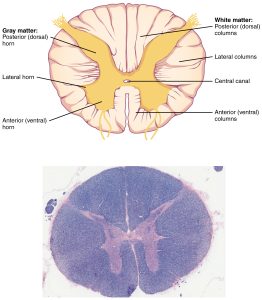
Recall that the central nervous system is comprised of the brain and spinal cord. We’ll consider the brain later, but first we will study the spinal cord.
Take time now to review the anatomy of the vertebral column (Unit 9). Recall that there are 7 cervical vertebrae, 12 thoracic vertebrae, 5 lumbar vertebrae, 5 fused sacral vertebrae, and 3-4 fused coccygeal vertebrae. The vertebrae are numbered from top to bottom, with a prefix indicating cervical (C1-C7), thoracic (T1-T12), lumbar (L1-L5), or sacral (S1-S5). These will surround the spinal cord, but neurologists also define spinal cord segments which bear a relationship to the vertebrae nearby.
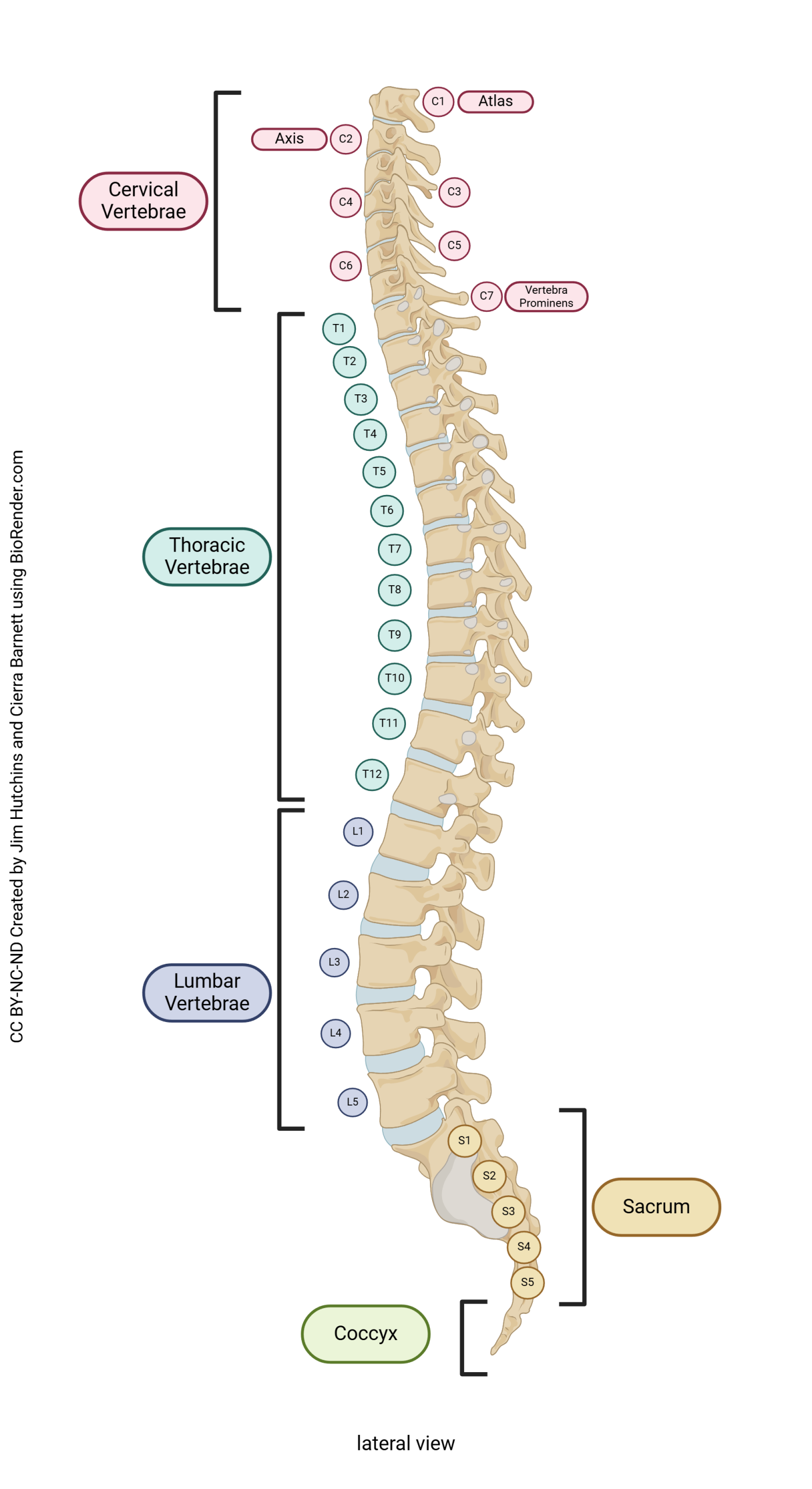
The spinal cord is about the diameter of your little finger at its largest (where it connects to the brain) and tapers to a point at its end (the filum terminale, “terminal thread”).
In cross-section, the spinal cord is oval or round and consists of an H– or butterfly-shaped central core of gray matter surrounded by white matter (i.e., myelinated axons traveling together over a great distance). Posterior (dorsal) roots of spinal nerves bring sensory information into the spinal cord. Ventral (anterior) roots of spinal nerves carry motor information away from the spinal cord.
Numbering Spinal Nerves and Their Roots
There are seven cervical vertebrae and eight cervical nerves. C1 nerve comes out above C1 vertebra, between the occiput of the skull and the atlas (C1 vertebra). C2 nerve comes out above C2 vertebra (axis), and so forth, until C7 nerve, which emerges from above C7 vertebra. Then we have C8 nerve, which emerges from below C7 vertebra. T1 nerve comes out below T1 vertebra, and from there down, that’s how the nerves are named: by the vertebra above.
The H-shaped gray matter is further subdivided into a posterior (dorsal) horn, which processes the sensory information brought in by the posterior root; and an anterior (ventral) horn, which contains cell bodies of α motor neurons (alpha motor neurons) controlling muscles. The axons of the α motor neurons form the anterior root of the spinal nerve, which carries motor commands going out to muscles.
At thoracic and upper lumbar levels, there is also a lateral horn (also called the intermediolateral cell column) which contains the cell bodies of the sympathetic neurons we saw in Objective 1.
The spinal cord ends in a bundle of nerves called the cauda equina (“horse’s tail”), which floats in a bag of CSF. This allows the clinician to withdraw CSF in a procedure called a lumbar puncture.
The white matter of the spinal cord is on the outside (superficial). It contains the axons of neurons that are either carrying information from the cerebral cortex of the brain to the spinal cord (called corticospinal) and from the brainstem to the spinal cord. Collectively, these are called descending tracts. There are also axons of nerve cells carrying information from the body, or from the spinal cord, to the brain. These are collectively called ascending tracts.
The white matter is further subdivided into three zones that are named pretty logically. The posterior (dorsal) horn gray matter extends to the surface and forms the “walls” of a posterior column. In the lateral white matter is the lateral column. The anterior (ventral) white matter is the anterior column.

There are three basic shapes of neurons. One of these, the unipolar neuron, is found in skin sensory pathways. Modified dendrites are found in the dermis of the skin. They decide whether to create an electrical signal (action potential) within the dermis; if an action potential is created, it travels without modification along a long axon within a spinal nerve and into the posterior horn of the spinal cord directly. These axons also form the posterior roots of the spinal nerve.
Note that the previous paragraph described modified dendrites and an axon, but did not mention the cell body. Where is the cell body? It is located in a posterior root ganglion, a collection of nerve cell bodies found in the PNS. The posterior root ganglion (also called a dorsal root ganglion) is found just outside of the vertebral column and is therefore not covered by bone like the CNS structures are.
Motor information is processed and sent by α motor neurons whose axons travel out the anterior root.
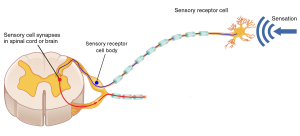
Just outside the enclosure of the vertebrae, the posterior root and anterior root join anatomically to form a spinal nerve. (Notice that the information in the spinal nerve is traveling in both directions: sensory information entering the CNS via the posterior root, and motor information leaving the CNS via the anterior root.)
As we saw in Objective 1, there is a different anatomical setup for the sympathetic nervous system. Autonomic motor neurons are found in the lateral horn from thoracic level 1 (T1) to lumbar level 2 (L2).
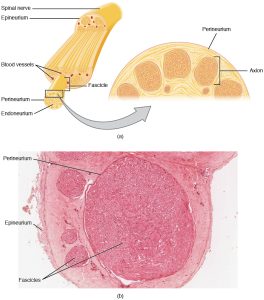
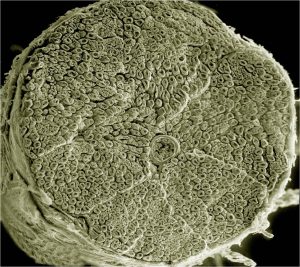
The microscopic structure of spinal nerves is shown in this diagram and scanning electron micrograph. As we’ve seen previously, spinal nerves are mixed: they contain motor neuron axons (both somatic and autonomic) as well as sensory neuron axons. Individual axons may be wrapped by Schwann cells with a myelin sheath (myelinated). Alternatively, they might be covered by a Schwann cell without being wrapped in myelin (unmyelinated).
As with muscle, there are three types of connective tissue sheath around nerve axons.
- endoneurium surrounds individual myelinated axons;
- perineurium surrounds bundles of axons, called fascicles;
- epineurium surrounds the entire nerve.
At several places in the body, spinal nerve roots and spinal nerves swap axons around so they don’t always take straight line paths. Because these structures resemble a braid, they have the Latin name for braid: plexus (plural plexi).
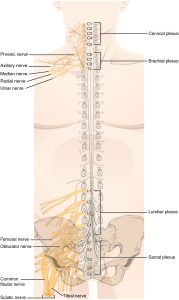 There are, in all, four of these braided nerve structures associated with the spinal cord.
There are, in all, four of these braided nerve structures associated with the spinal cord.
- The cervical plexus is in the neck. It receives nerves from the C1 through C5 spinal cord segments, and gives rise to several important nerves. The most important of these is the phrenic nerve, which innervates the diaphragm and makes breathing possible. Its contributory nerves are C3, C4 and C5, thus the mnemonic “C3, 4, 5, keep the diaphragm alive.”
- The brachial plexus receives contributions from C5-C8 and T1. Its major exiting nerves are the radial nerve (innervating the thumb and nearby structures), the median nerve (middle finger) and ulnar nerve (little finger). The nerves fight over the index and ring fingers.
- The lumbar plexus is associated with the lumbar spinal cord (roots L1–L5) and innervates the upper thigh.
- The sacral plexus receives contributions from L4–L5 and S1–S5. One huge nerve, the largest in the body, emerges from the sacral plexus: the sciatic nerve. Almost every axon innervating muscles in the leg, and almost all sensory information from the leg, is carried by the sciatic nerve. Imagine how painful inflammation or compression of this nerve would be, a condition called sciatica.
Media Attributions
- Spinal cord cross section diagram and nissl © Betts, J. Gordon; Young, Kelly A.; Wise, James A.; Johnson, Eddie; Poe, Brandon; Kruse, Dean H. Korol, Oksana; Johnson, Jody E.; Womble, Mark & DeSaix, Peter is licensed under a CC BY (Attribution) license
- Vertebral Column © Jim Hutchins and Cierra Memphis Barnett is licensed under a CC BY-NC-ND (Attribution NonCommercial NoDerivatives) license
- Sensory Receptors © Betts, J. Gordon; Young, Kelly A.; Wise, James A.; Johnson, Eddie; Poe, Brandon; Kruse, Dean H. Korol, Oksana; Johnson, Jody E.; Womble, Mark & DeSaix, Peter adapted by Jim Hutchins is licensed under a CC BY (Attribution) license
- Posterior root ganglion © Betts, J. Gordon; Young, Kelly A.; Wise, James A.; Johnson, Eddie; Poe, Brandon; Kruse, Dean H. Korol, Oksana; Johnson, Jody E.; Womble, Mark & DeSaix, Peter adapted by Jim Hutchins is licensed under a CC BY (Attribution) license
- Spinal nerve © Betts, J. Gordon; Young, Kelly A.; Wise, James A.; Johnson, Eddie; Poe, Brandon; Kruse, Dean H. Korol, Oksana; Johnson, Jody E.; Womble, Mark & DeSaix, Peter is licensed under a CC BY (Attribution) license
- Spinal nerve human © Ellisman, Mark and Deerinck, Tom, National Center for Microscopy and Imaging Research is licensed under a Public Domain license
- Nerve plexuses © Betts, J. Gordon; Young, Kelly A.; Wise, James A.; Johnson, Eddie; Poe, Brandon; Kruse, Dean H. Korol, Oksana; Johnson, Jody E.; Womble, Mark & DeSaix, Peter is licensed under a CC BY (Attribution) license

